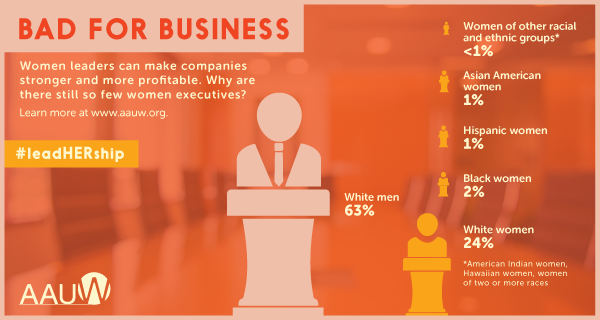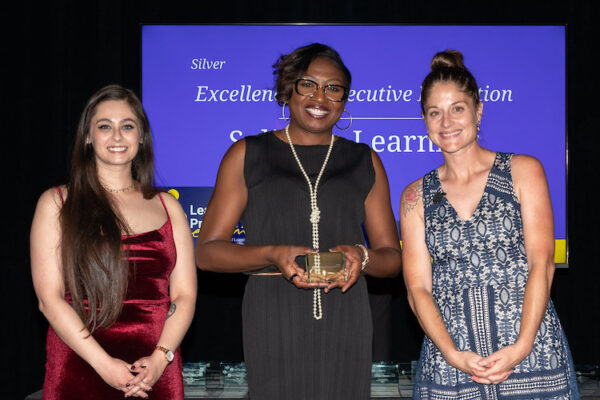Despite the fact that women earn almost 60 percent of undergraduate degrees and 60 percent of all master’s degrees in the U.S., they comprise only 25 percent of executive- and senior-level officials and managers, hold 20 percent of board seats and only 6 percent are CEOs, according to the “Women’s Leadership Gap” report by The Center for American Progress.
According to a 2017 study by Lee Hecht Harrison, “Elevating Women in Leadership,” most organizations see this as a problem but haven’t been successful in fixing it. The study found that 82 percent of organizations surveyed believe advancing women is a critical business issue — yet only 28 percent of HR leaders are satisfied with their organization’s ability to do so.
Jill Ihsanullah, senior vice president of consulting at consulting firm Linkage Inc., said many organizations and leaders are well-intentioned in advancing women leaders but don’t follow through. “Organizations will say all the right things about advancing women, but when it comes down to it, the decision they make is to promote a man,” she said.
Next Concept HR Association CEO Greg Morton agreed there needs to be more action in changing the demographic of leadership. “Folks often push back at the fact that they are expected to put a mix of leaders out there, whether it’s male versus female or people of color,” Morton said. “They say, ‘It’s not my fault [the applicants] are all white men.’ Well, it is your fault because you have to be proactive in solving this. You can’t just sit back and let things happen the way they always have and say it’s not your fault.”
A 2016 American Association of University Women report, “Barriers and Bias: The Status of Women in Leadership,” found that the lack of women in leadership roles can be examined through structural barriers preventing women’s assent to leadership and the gender bias that continues to affect them in the workplace.
Structural Barriers
AAUW researcher and author of the “Barriers and Bias” report Kevin Miller said paid family leave and child care offerings would make it more possible for women to meet their care requirements at home while also meeting their obligations in the workplace.
According to the report, only 12 percent of U.S. workers in the private sector have paid family leave through their employer. Further, women without access to paid leave are significantly more likely to quit their jobs after giving birth than those with paid leave.
Miller said equal pay also would help advance women in leadership. As women gain higher levels of pay, they are subsequently perceived as better candidates for senior positions and are less likely to take time out of the workforce, he said. “When a couple has two incomes but one is higher, the person with the lower income is more likely to take time out of the workforce to raise children or for some other purpose. By giving women higher pay and equal pay, it makes them less likely to take breaks out of the workforce, which means they will continue to climb ladders more quickly,” he said.

Currently, women make up only 27 percent of those who are paid $100,000 or more per year, according to the report. The income gap for minority women is even larger. The report found that black and Hispanic women make up only about 4 percent of the 9 million U.S. workers who make $100,000 or more annually.
Some researchers argue that despite structural barriers, a woman’s success is still mainly led by active ownership of her career. “Claiming the Corner Office: Female CEO Careers and Implications for Leadership Development,” a report by the Saïd Business School at the University of Oxford, asserted that women’s self-acceptance, self-development and self-management are the driving forces to advance their careers.
“Certain behaviors typically observed more in women are also said to undermine their career chances, such as disinclination to self-promote, limiting volubility (i.e., the time spent talking) and invisibility (i.e., ‘states of exclusion’ or difference because of a lack of women in leadership roles). In short, whether consciously or unconsciously, women tend to undermine their own efforts and contributions,” the report states.
But Miller argued that instead of training women to demonstrate these attributes, the focus should be on making sure that the environment and the institutional culture structures are what they need to be to promote women in leadership. “I don’t think the problem has ever been that women aren’t interested in leadership positions or higher paying jobs,” he said. “The problem is there are these really complex layers of barriers and bias that are preventing them from achieving them.”
Miller said the University of Oxford isn’t the first organization to suggest that what women need has been inside them all along, which, he said, is frankly too much like a Disney movie to be true. He said that’s essentially the advice of the Lean In movement, that “if you want it, you have to go for it.” Facebook COO Sheryl Sandberg popularized the movement with her book “Lean In,” which suggests that success relies on individual initiative.
However, instead of training women to have a “leaning in” type of philosophy, more useful lessons could be offered in salary negotiation or helping women understand the best process for asking for a raise or negotiating a higher salary when they get a new job, Miller said.
Training Against Bias
Miller said there are many ways companies can proactively address the issue of gender bias. He said learning leaders should train to reduce implicit bias among employees — the tendency for people to have a subtle or sometimes even unconscious bias against women leaders. Learning leaders should consider evidence-based diversity training that focuses on bias and stereotypes to retrain people to instinctively think about not just men as natural leaders but women as well, he said.
Learning leaders can also encourage mentorship and sponsorship programs. Sponsorship is a form of mentorship in which sponsors share both status and opportunity. According to the AAUW report, this type of professional relationship has been shown to be more effective than traditional mentorship.
Ihsanullah said sponsorship can be a great way to get male leadership excited about changing cultures and advancing women in a way that’s natural and has a big impact. “In sponsorship, senior leaders are sharing their political capital,” she said. “A senior leader is sponsoring the career of a woman, a member of another underrepresented group, or any employee. It becomes their responsibility to ensure that an employee’s name comes up in discussions … to really advance the conversation around female talent in the organization.”
Beyond formal programs, Miller said it’s important that women are included in informal cultures of mentorship and sponsorship as well. “If male senior leaders are more likely to do some sort of informal mentoring with other men, that can negatively impact women,” he said. “Make sure that if you invite your colleagues out for a drink, you invite both male and female colleagues and you do it in a way that is workplace appropriate.”
In changing workplace culture to address the lack of women in leadership, Miller said specific issues differ from place to place but the one thing that remains constant is the need for buy-in from the very top, which often consists mostly of men.
“Where we see faster progress is where existing leadership takes ownership of the problem and chooses to invest energy, time and money as needed to fix it,” Miller said. “Some of the solutions may be common, some may be specific to a particular workplace or sector, but it’s important to recognize that it’s a societywide problem and as a result our solutions need to be careful, deliberate, complex and multipronged as necessary.”
Get a behind-the-scenes look at leadership and management with CLO Breakfast Club Podcast.
















